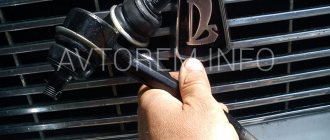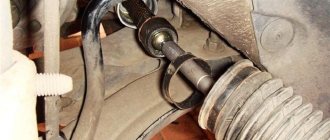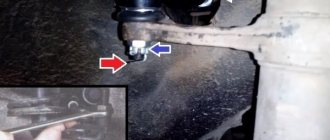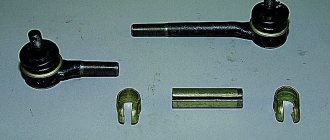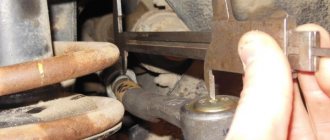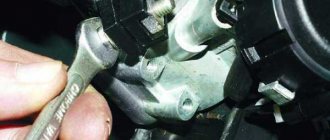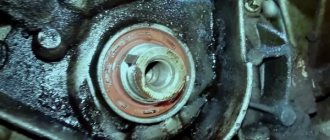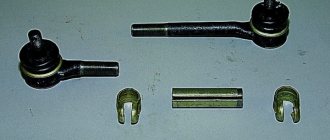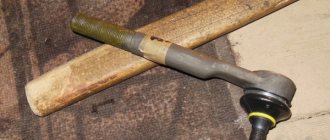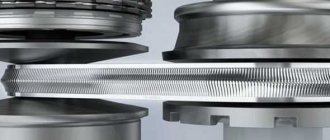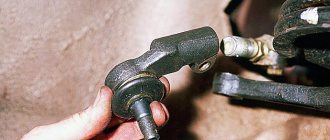One of the indispensable elements of the steering system of vehicles is the steering rod. And the task of this traction is to prevent the side wheels from sliding when the vehicle turns. This means that if the system is functioning properly, each controlled wheel should turn to different angles, namely at a small angle on the outside, but on the contrary on the inside at a large angle. The system itself includes different traction rods, namely middle, left and right, that is, left and right tire levers. Of course, the designs of levers are different, and not every one may fit your car. This means that you should take the choice of a part seriously and carefully, so as not to make a mistake when purchasing, because the replacement of this part is carried out exactly according to its type.
PURPOSE OF STEERING ROD
As stated above, different machines have a huge number of properties that complement this mechanism, but the very essence of the drive remains the same. This means that the connection between the lever of this mechanism, as well as the longitudinal element, is created through hinges. And at the moment when the bipod begins to turn, the central rod moves to the left or right side, but the turning of the wheels in the right direction is ensured by the lateral rods.
There is also a steering mechanism that is less simple in operation, the so-called rack and pinion type. And it differs in that during operation it uses only 2 rods; with the help of them, vehicles turn the wheels in the appropriate directions, and also have a connection with the rotary levers, through the least effort on the part of the driver.
Replacing only the boot
The steering tip boot prevents dirt and moisture from entering the part. It is a protective case made of rubber, silicone or plastic. If the boot is cracked, then sooner or later the tie rod tip or pin itself will fail.
The initial steps required to replace the boot are consistent with the effort required to replace the entire tip.
- Using a jack, the wheel is lifted, the car is placed on a stand, after which the wheel is removed.
- Then the tip mount is coated with WD-40. Next, the tip is removed using a puller.
- You need to pry the boot with a screwdriver and use circular movements to remove it from the steering rod pin.
- Then a new boot is installed. First you need to lubricate the tip pin mounting with grease. Then you need to install a screwdriver on top of the boot, and then use light hammer blows to push the boot onto your finger. This must be done carefully so as not to damage the rubber of the boot.
- After installing the boot, the steering tip is installed. This must be done in reverse order. First, the tip is inserted, and then the crown nut securing the tip is tightened using a socket wrench.
As you can see, you can replace the tips or boot yourself. However, after this you will still need to visit a car service center. This will have to be done to adjust the wheel alignment. In this case, you should not rely on the marks set - without professional help from specialists, there is a high risk of damaging the car’s rubber during subsequent use.
TIE ROD JOINTS
The most important components of the side rods are the steering rod joints, but they are also called tips. They are designed to be effectively connected to so-called threaded lugs. The hinges themselves look like hemispherical fingers. They are also very unreliable, and therefore problems arise specifically in them. But in order to replace the steering rod joint, you need to have a complete assembly of the mechanism, because it is impossible to repair or restore it. In this regard, remember, when you change the hinges on one side, it is recommended to replace them on the next, so as not to encounter this problem again.
Knock in the steering rack: how to determine how to eliminate the knock
The design of a car includes dozens of different components. Some of them become unusable during operation, as evidenced by the appearance of specific sounds. One of these is a knock in the steering rack. In this article you will find useful information on how to determine the malfunction, what methods are available for diagnosing and repairing the breakdown.
A few words about the steering rack
Modern rack and pinion mechanisms use two main components: the rack and the pinion. Thanks to such a simple design, the part has a long service life and is capable of properly performing its functions for more than 100 thousand kilometers. However, failure is possible, and then you will have to carry out repairs.
The operating principle of this device is also quite simple. When you turn the steering wheel, the rack begins to move in a given direction, which sets the rods in motion and also ensures that the wheels turn. It is recommended to carry out diagnostics immediately upon detecting a knock, since this component is responsible for driving the vehicle.
Causes of knocking
Despite its reliability, the rack design has several disadvantages. These include sensitivity to shock loads, difficulty in installation and a tendency to constant vibration. Under the influence of external loads, any component, of course, becomes unusable, which is why a characteristic knock appears.
The main reasons for this phenomenon include:
- The plastic bushing installed on the right or left side of the rack is severely worn. There is a strong backlash in the design, due to which drivers hear extraneous noise. This is especially noticeable when driving on a bad road.
- Poor tightening of connections in the steering mechanism design. It can be fixed quite simply (you need to tighten all the fasteners well).
- The appearance of corrosion, which destroys the metal and contributes to the formation of backlash.
- Damage to anthers. Dust, sand and dirt get into the structure, increasing wear of the part.
- Deformation of the crankcase, resulting in an incorrect angle between the screw and the teeth.
- Development of the resource of the central tooth.
A common problem is leakage in cars with power steering (power steering). The power steering design uses a special pump, which creates additional force when turning the steering wheel, making the process easier for the driver. When the seals fail, the pressure in the system drops, the working fluid leaks out, and accordingly, the steering wheel rotates with difficulty. As a result, this will lead to accelerated wear and knocking.
Prolonged downtime can cause the shaft to rust and difficulty turning the steering wheel, accompanied by knocking. If a hum also appears along with the knocking, this indicates a breakdown of the power steering pump. It does not build up the required pressure. The way out of the situation is to replace this component.
Most slats are made of soft metal that will wrinkle over time, so this part should be inspected regularly. Now you know why the steering rack is knocking, which means you can fix the problem.
Checking the steering rack
Knocking in a car can occur for several reasons. Many motorists ask how to determine a knock in the steering rack. You can do this in the following ways:
- Visually and audibly. You may hear superficial and internal knocking. The first occurs due to a ruptured boot. In this case, the tip is not protected in any way, so it quickly fails. An internal knock indicates a more serious breakdown, which is best diagnosed at a car service center.
- Check if there are any gaps in the steering rod joints.
- Disconnect the cross rods. If the knocking noise remains, then the problem is in the steering rack.
It is recommended to put the car on a lift or pit, and then ask someone to turn the steering wheel. Being directly under the car, you are more likely to be able to determine the source of the sound.
When purchasing a used car, diagnostics can become more complicated. The damage will be difficult to determine, since the previous owner may have completely replaced the boots with new ones, leaving the underlying problem without a solution. In such situations, it is better to completely dismantle the entire structure.
Repair or complete replacement
If funds allow, then it is worth purchasing new parts, as they guarantee maximum service life. However, the cost of the gearbox is quite high. There is always a temptation to buy non-original parts. Sometimes they will not be inferior in quality to products from the official manufacturer, but there is always a chance to stumble upon a low-quality product.
An alternative option is to make high-quality repairs. To do this, a special repair kit is purchased, and then the oil seals, anthers and other components are replaced. If you have some experience in car repairs, then you can do it yourself. Otherwise, it is naturally recommended to contact a specialized auto repair shop. Repairing a power steering system is difficult, so it must be done by highly qualified craftsmen.
Repair procedure
Having purchased the necessary repair kit, you can begin dismantling. Here it is necessary to follow a certain algorithm consisting of the following steps:
- Completely dismantle the steering rack.
- Remove the tie rods.
- Clean the structure from dirt accumulated during operation.
- Replace worn parts.
- Inspect the shaft and install a new one if necessary.
Why remove the tie rods? This will greatly simplify the process of installing new boots. By pulling them onto the corresponding protrusions on the rod, you can achieve maximum tightness. Before assembling the rack, be sure to lubricate the internal oil seal.
If your car has a hydraulic booster, then you will first need to disconnect the high pressure pipes and then drain the working fluid into a prepared container. It is not recommended to remove the gearbox with hydraulic power steering yourself. The procedure involves dismantling the subframe, and it is impossible to do it alone.
The described technique will eliminate knocking in the steering rack. To complete the procedure, you will need a set of keys and screwdrivers, a garage with a pit. You can also always contact a car service center, where all the above operations will be performed by auto mechanics. But be careful, as they may jack up the cost of repairs or supply low-quality consumables.
If the steering rack is knocking, is it okay to drive?
Of course, your car will drive a certain number of kilometers with a knock, but it’s not worth taking risks and continuing to drive with it. In the worst case, the steering mechanism may simply jam. If this happens at high speed, the consequences will be dire.
Protect yourself and other road users. If knocking or humming occurs in the structure, be sure to carry out diagnostics or contact a service station. On some cars, due to the nature of the suspension, a slight knock in the rack may be quite normal. You can get detailed information about the problem for your make and model of car on thematic forums on the Internet.
Prevention measures
You can avoid knocking in the steering rack by performing several measures, among which it is worth noting:
- Reducing sudden braking and starting to zero (unless circumstances require it). Aggressive driving style greatly affects the wear of rack components.
- Do not use curbs as barriers when parking. As previously mentioned, the steering rack is extremely susceptible to shock loads.
- Drive over speed bumps, potholes, potholes and other irregularities at minimum speed. When driving at high speed over such obstacles, the steering rack will experience enormous loads.
- Carry out regular inspection of oil seals, boots and other structural components. By detecting their destruction in time, you will prevent accelerated wear of parts.
- As soon as any signs of malfunction appear, perform diagnostics.
- Do not hold the wheels at the maximum turning angle for more than 5 seconds, as this will negatively affect the gearbox.
All this will help eliminate the appearance of extraneous noise in the rack, and will also extend its service life.
In most cases, knocking can be eliminated by cleaning or replacing consumable components (oil seals, boots). The cost of a high-quality repair kit is relatively low. Buying new parts will significantly impact your wallet, but in some situations this is the only right option, so you should not skimp on your safety.
SOURCE OF DAMAGE TO STEERING LINK
The main and most common breakdowns are:
· Unintentional vibration and steering wheel shock;
· Absolutely any unintentional impacts and knocks, mainly they can be observed on the right;
· An incomprehensible increase in the steering column loof, which a motorist may notice at high speeds;
· Very difficult to turn the steering wheel during turns;
· When driving smoothly, the machine deviates to the right or left.
This means that if you suddenly notice something from the above, then you need to take it seriously and not check your vehicle the next day. Thus, it is necessary to diagnose the car, namely the steering system, and in case of breakdown, replace the tip of the steering rod mechanism.
What is needed for repair
Replacing steering wheels will require you to have the following tools and devices:
- Jack.
- Balloon wrench.
- Steering wheel end remover.
- Set of spanners.
- Pliers.
- Flat thin screwdriver.
- An open-end wrench and a lever for it to unscrew the hinge from the rack. In this case, the lever is needed due to the strong tightening of the assembly.
- Car stands.
- Shoes.
It also doesn’t hurt to have a couple of nuts for fastening the fingers and several cotter pins of suitable size. Be sure to buy the required number of plastic clamps of the appropriate length to secure the steering rack boot. Such clamps can be used in any case, even if your car uses metal ones.
Replacing the steering rod, even if one joint has been replaced, requires mandatory adjustment of the steering wheel angles (geometry). You can also set the camber yourself.
SELF-DIAGNOSTICS
Before turning to a service station for help, you can inspect this system yourself. But here you need to strictly adhere to the following:
· The steering tips should move along the axis of the fingers, no more than 1.5 mm, and if more, then it will be necessary to change the tip with the ball;
· Check the connection of the clamp on the coupling of the rod itself, namely how it is tightened.
· Also carefully inspect the covers that help protect the hinge tip. There may also be cracks or tears in the covers, and if found, the cover should be replaced.
But the most common malfunction of the steering drive is the breakdown of the hinges and their wear, namely the tips, the so-called steering rods.
Also, to identify faults in the steering mechanism, you do not need to contact a service station or use specialized equipment. Just like you just need to put your hands on the steering wheel and listen to see if the steering column is making any extraneous sounds. Of course, an experienced motorist can easily determine the non-standard behavior of his vehicle, which may subsequently contribute to an accident.
So, what methods are more effective for detecting problems:
1. When the vehicle is parked, you should turn the steering wheel (right, left) and take a closer look at how the wheels behave in reverse movement; if the wheels do not respond to the rotation of the steering wheel, then there is some kind of malfunction.
2. It is also necessary to pay attention directly to the boot, whether it has any damage (scratches, tears) and if there are such signs, you should immediately replace it.
avtoexperts.ru
It is necessary to clarify the point, some car enthusiasts do not distinguish the difference between a steering rod and a rack. And the differences are quite significant. You must understand that the rack is a full-fledged control mechanism, inside which a gear shaft (rack) moves, connecting to the rods, left and right. You can come across the concept of medium thrust, keep in mind that it is present in “worm” type systems, for example, the VAZ (Classic) or BMW models.
Photo: GAZ Cyber steering rods
By the way, the “Germans” used different types of steering systems on their models; you can find both a “worm” and a rack, for example, E39, E34, E38, etc.
Now the concept itself, steering rod, what is it? This is a part of the steering system of any car, which converts the physical impact of a person on the steering wheel into turning the wheel. Simply put, these are the connecting links between the steering column, steering wheel and wheels (in particular the steering “fists”). Without them, you simply would not be able to turn the wheel.
Device
Varieties
There are three varieties as such:
• Left
• Average
• Right
Middle tie rod
You can often find the decoding as longitudinal and transverse thrust. The second is the so-called middle thrust or central, as it is also called. The first is the left or right side. Remember that such a number of elements is inherent only in the “worm” type of mechanism. Some note that this feature negatively affects handling, because the impacts from uneven roads are transmitted directly to the steering wheel, from which the driver feels everything personally. There are more hinged (moving) elements, which means you have to monitor the condition of the parts much more often.
In racks, there is no such variety; the task of central thrust is performed by a toothed rack moving along the cylinder. Depending on the type of rack, it can be either “dry” or power steering or power steering. The second type includes special seals that prevent fluid leakage. The steering rods (left and right) are connected to the rack. Depending on the modification of the car, the connections can be either hinged or classic threaded. The connection between the rods and the steering knuckles occurs through hinges.
Device
Do not forget that they are separated and can be adjusted. Some come molded together with tips, without the possibility of adjustment. In other modifications, special bushings are provided at the edges into which the tips are screwed, with the possibility of adjusting the latter. Therefore, pay attention to what type you have; after replacement, you will need to adjust the camber.
Resource, faults and their symptoms
Nobody gives exact terms of operation. It is generally accepted that in general, in the entire control device, no matter what type it is, traction has the longest service life. They call the time frame 100,000 – 150,000 km. and even 250,000 km. But here it is necessary to make an important emphasis; in many respects everything depends on the driving style and the characteristics of the road surface. For example, on bumpy roads, it is clear that parts wear out faster.
While operating a car, every driver needs to pay attention to the appearance of strange sounds and deterioration in controllability; these may be the first “bells” that some element is failing.
Broken tie rod
So, the signs:
• A knocking or grinding noise appears while driving on uneven roads.
• Slight knocking when turning the steering wheel.
• Eaten rubber on one side.
• Backlash and general looseness of the element.
• Steering wheel wobble.
• The car “drives” if the steering wheel is straight.
• The “wheel” rotates slowly.
• A torn boot, as a rule, after exposure to dirt, dust, moisture, the hinge does not “live” for a long time.
The boot is torn
Often, malfunctions are associated with worn fasteners, both on the tips and on the side of the steering mechanism (for example, broken threads). After a strong blow to the suspension, it flew into a hole, it is not uncommon for the plane to change or bend. In such cases, it is better to replace the part, because restoring its original appearance without special tools will be labor-intensive. And as you understand, a “crooked” element cannot be distinguished by anything good in management.
Separately, I would like to say that the traction device includes a tip; most of the symptoms may be associated with its malfunctions. For example, the “finger” or polyurethane gasket that secures the hinge in the “socket” has worn out, which generally leads to the appearance of play.
Replacement
If diagnostics show wear, for example, of the tip, you can get by with replacing it. But, if the hinges are out of order on both sides, the threads are broken or the rod is basically maintenance-free, then, of course, a complete replacement will be needed. Therefore, we will provide a small work plan, what needs to be taken into account and what features of the repair. So:
• Loosen the wheels. We lift the car with a jack.
Don’t forget about safety precautions, place a brick or “shoe” under the wheel. Don't forget, you need to do this on the opposite side of the rise. That is, they raised the left side and placed a brick under the rear right wheel.
• So, the wheel has been unscrewed, now the rods are open to you. Remove the cotter pin and unscrew the pin nut.
Unscrew the steering wheel nut
By the way, it is advisable to measure the length of the old element; this will help you independently adjust the “fit” of the new part.
Let's take it off
• If you are removing only the tip, just unscrew it from the sleeve. But, if we are talking about a complete replacement, then you will have to remove the anthers (carefully), and only then unscrew the entire element. As a rule, key grooves are made on the rod for 32.
Next you need to remove the boot
New tie rod installed. Replacement photo - drive2.ru user Valery Zavgorodniy
Assembly is carried out in reverse order.
Symptoms of faulty tie rod ends
What does the steering end look like?
Before describing the main symptoms of a malfunction of the steering tips, we will indicate the main enemies of this part:
If we take careless and inept driving of a car out of the equation, then the main problem for steering wheel ends is damage to the boot. It is dust, dirt, and moisture that can damage the steering tip in a short time. Therefore, inspect the anthers as often as possible in order to notice their destruction in time.
If we talk about the actual signs of malfunction of the steering tips, then, first of all, these are problems with the car’s reaction to steering movements. Inadequate turning of the wheels, wobbling of the car to the sides when you let go of the steering wheel, excessive beating of the steering wheel on bumps and holes, extraneous knocks and crunches in the front part of the suspension, especially when turning the steering wheel, all these are signs that it may be time to change the steering wheels tips. Although, some of the above symptoms may have other causes that are in no way related to the condition of the steering tips.
